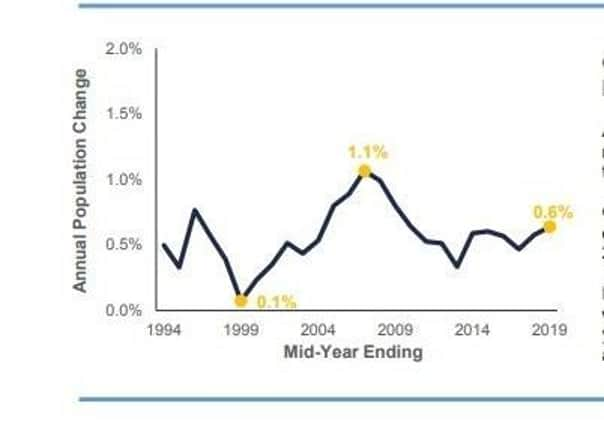Almost 40 per cent of Province’s growth in population down to immigration as Northern Ireland nears the two million mark


The data, from the Northern Ireland Statistics and Research Agency (NISRA), shows that as of mid-2019, there were an estimated 1.894m people living in the Province.
This is an annual increase of 12,000 people (0.6%) on the 2018 estimate – a similar growth rate to the three other countries in the UK.
Advertisement
Hide AdAdvertisement
Hide AdHowever, the Republic of Ireland saw a growth of rate of 1.3% in the year to April 2019 – taking its population to 4.92m.
In 1926 – the first census after the creation of the state in 1921 – there were only 1.26m people in the Province.
This latest annual increase, from mid-2018 to mid-2019, was mainly driven by natural growth.
There were 22,600 births and 15,300 deaths, making a net growth of 7,300 people to the Province’s population. In addition 25,600 people came to Northern Ireland and 20,800 left – spelling a net inward migration of 4,800 people.
Advertisement
Hide AdAdvertisement
Hide AdWhen broken down into percentages, that means 39.66% of the growth from 2018 to 2019 was from immigration.
This is not an especially large number compared to the long-term, UK-wide pattern.
For example, the Migration Observatory at the University of Oxford states: “More than half (56%) of the increase of the UK population between 1991 and 2018 was due to the direct contribution of net migration.”
It also goes on to add that a net inflow of new migrants to the UK is expected to account for 73% of total population growth by 2028.
Advertisement
Hide AdAdvertisement
Hide AdThe Oxford observatory further states that, in England and Wales, net international migration is projected to make the largest contribution to population change over the next 25 years (+8% and +5%, respectively), but that Scotland would experience population decline of 8% in the absence of net international migration (or cross-border migration from other parts of the UK).
In contrast, in Northern Ireland has the highest fertility rate amongst UK nations, and “natural change without net migration is projected to be the main driver of future population trends”.
The number of people aged 65 or over) increased by 2.1% (to 314,700 people) – with NISRA noting this is “over three times faster than the total population”.
The proportion of the population aged 65 or more has increased from 13% per cent in mid-1994 to 16.6% in mid-2019.
Advertisement
Hide AdAdvertisement
Hide AdThe proportion of population aged 15 or under dipped from 25.4% in 1994 to 20.9% in 2019.
A message from the Editor:
Thank you for reading this story on our website. While I have your attention, I also have an important request to make of you.
With the coronavirus lockdown having a major impact on many of our advertisers - and consequently the revenue we receive - we are more reliant than ever on you taking out a digital subscription.
Subscribe to newsletter.co.uk and enjoy unlimited access to the best Northern Ireland and UK news and information online and on our app. With a digital subscription, you can read more than 5 articles, see fewer ads, enjoy faster load times, and get access to exclusive newsletters and content. Visit https://www.newsletter.co.uk/subscriptions now to sign up.
Advertisement
Hide AdAdvertisement
Hide AdOur journalism costs money and we rely on advertising, print and digital revenues to help to support them. By supporting us, we are able to support you in providing trusted, fact-checked content for this website.
Alistair Bushe
Editor